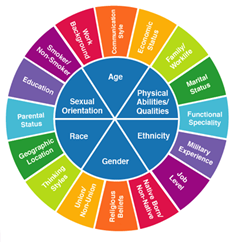Racial health disparities have been a major focus in health care in recent years. Growing research illustrates the negative impact implicit bias has on racial and ethnic minorities in the United States.
The data reveal these groups experience higher rates of illness and death in a wide range of health conditions (diabetes, hypertension, obesity, asthma, and heart disease) when compared to whites. This can be a difficult issue to unpack, especially in health care, an industry that is designed ultimately to help others. While organizations and hospitals across the country are working tirelessly to achieve health care equity, there remains significant work to be done.
In October, CHPSO and HQI had the opportunity to host a webinar with one of the nation’s leaders in addressing equity and inclusion in health care. Michelle van Ryn, PhD, MPH, is the founder, CEO, and lead scientist of Diversity Science, a public benefit corporation with the mission to translate best current evidence into practical and effective approaches for equity, diversity, and inclusion.
She has made it her mission to combat inequities in clinical encounters. Dr. van Ryn has conducted extensive research on understanding and advancing the conditions that allow people to be unbiased, skilled, and authentic in the way that they interact with their collages and the people they serve. Much of her work has improved the national awareness of how providers contribute to disparities in patient care and has led to greater understanding of how health care encounters can positively impact patient outcomes and quality and safety.
Dr. van Ryn began the webinar by discussing the importance of first focusing on one’s own core values, as they are a source of personal integrity, identity, and self-worth. When talking about difficult topics, she said individuals should take a moment to look at their own core values, as it is helpful in opening them up to new ideas and encourages a growth mindset.
She continued the discussion by examining how powerful social identities are and the effects they have on us. Individuals are extremely motivated to protect their social identities from being undervalued to protect one’s own self-esteem. She stated that the challenge is that the social identity group that is the most important to individuals (race, ethnicity, gender, sexual orientation, religion), is not always the social identity that others see. Dr. van Ryn used the example of transgender/gender non-conforming patients not having their social identity recognized on medical intake forms. This can make patients who identify as transgender/gender non-conforming feel invisible and has a powerful effect on the way they experience the world, the way they present themselves in clinical encounters, and even can manifest through physical health effects.

So, how do individuals respond when their social identity is threatened? Dr. van Ryn presented several results of studies to demonstrate the negative impact that social identity threat has on the performance of individuals of various social identity groups:
- Girls do worse than boys on math tests when the gender question is asked prior to the test, but not when asked after the test.
- White golfers did worse than Black golfers when told they were taking a test of “natural athletic ability”. Black golfers did worse than white golfers when told the test requires “sport strategic intelligence”.
- Male nurses were more tentative and performed more poorly when told a simulation assessed empathy than when told it assessed patient management
- Men did worse on a test when told it was a test of “social sensitivity” than when told it was a test of “information processing”.
- Black test takers performed worse than white test takers when told it was a test that indicated intelligence. When told the test was a task that did not indicate intellectual ability, Black and white test takers performed at the same level.
Dr. van Ryn then discussed the effect social identity threat has on both the clinician and the patient. Societal stereotypes affect everyone involved in the clinical encounters, even if those involved are unaware of the effect. Both clinicians and patients can experience social identity threat (either unconsciously or consciously) when they believe they are being perceived or judged through the lens of a negative stereotype. Clinicians must be intentional and mindful in creating conditions that allow patients to show up fully. Patients who experience social identity threat may find it difficult to communicate to the provider and may appear disengaged.
Dr. van Ryn also addressed racial trauma, another factor that needs to be understood to ensure quality care. Racial trauma results from traumatic events such as racial harassment, direct racial violence, or witnessing racial violence. The role of patient can feel dehumanizing and can trigger trauma reminders. These reminders can then trigger intense emotional reactions and defensive behaviors. Trauma reminders can include:
- Being examined by a stranger
- Differentials in status and power
- Symptoms such as physical pain or respiratory problems
She explained that racial trauma is not the same as social identity threat but can manifest in patient behavior similarly. Patients who have experienced racial trauma may appear indifferent, hostile, or withdrawn. Unfortunately, if these behaviors are not understood as stemming from racial trauma, they may seem exaggerated or irrational. Clinicians can take these behaviors personally, which causes a negative response toward the patient.
One may ask, “Is there anything that can be done to prevent or mitigate the effects of social identity threat and racial trauma experience in clinical encounters?” Dr. van Ryn provided several strategies clinicians can utilize to protect themselves from personally experiencing social identity threats. She first suggested that the clinician should identify personal social identity threat triggers that affect their self-concept. An example she used was a female clinician feeling de-skilled when having to present to an all-male board room. When the clinician is in a position where he/she is experiencing social identity threat and feeling de-skilled, he/she should think about their personal unique characteristics, skills, values, or roles that they view as important and focus on an “alternate identity” that helps them feel powerful in that setting.
Dr. van Ryn then pointed out that humans are wired to scan for threats. Good intentions by clinicians are not enough. She presented three questions that patients will run through their mind when determining if a clinician can be trusted and not viewed as a threat:
- Am I being seen in terms of a group stereotype?
- Does this person, who has my life in their hands, value my humanity?
- Do they have empathy for me?
Dr. van Ryn concluded the webinar discussing the importance of clinicians being intentional in their approach to creating an environment that allows all patients to show up fully. One way clinicians can do this is through their language. Clinicians can start by making a list of questions that they ask patients every day and review this list to see how these questions could be modified to convey respect, caring, and partnership. Asking patients questions that allow the patient to think about and express their core values allows the clinicians to see the patient as their individual self and lets the patient show up fully. Taking a moment to see through the eyes of the patient and focusing on a common goal, allow the clinician and patient to remember that they are working together on the same team.
